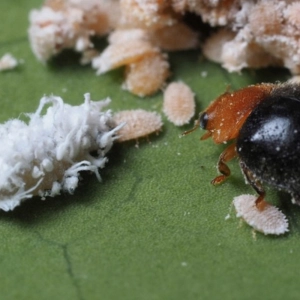Mealybugs are insects from the Pseudococcidae family of which there are more than 2,000 species. They are scale insects meaning their soft bodies are concealed underneath domed scales and they produce quantities of wax for protection.
They are considered pests, especially in the greenhouse and on houseplants as they feed on the sap of these plants and can transmit plant diseases.
Like aphids, mealybugs can live in symbiotic relationships with ants – who will protect them from predators because they feed off the honeydew they excrete.
Some species of mealybug lay their eggs in their protective waxy layer and can produce up to 100 eggs, other species deliver live young. They can take over a small houseplant extremely quickly!
Damage caused by mealybugs
Damage from mealybug feeding includes deformation, curling and stunting or yellowing of plant leaves. Many plants will lose flowers and fruit as a result of a mealybug infestation meaning yield can be significantly impacted.
Most species of mealybug will feed on the plant leaves and stems, but others will attack plant roots, while some can transmit harmful viruses. The honeydew they excrete can attract dark sooty mould, further impacting plant health due to reduced photosynthesis ability.
Identifying mealybug damage
You are likely to see a fluffy cotton white wax-like substance on plant leaves, leaf axils and other inaccessible parts of the plant.
You may notice the mealybugs slowly crawling underneath leaves, on flower stems and sometimes on the outside of containers. Most often however, you will see them at rest.
You may also see plant die-back, or in extreme cases, mealybugs can cause the death of the entire plant.
How to get rid of mealybugs
It’s always better to inspect the leaves of houseplants before buying them or bringing them inside. But if you notice a few on your new plant, remove the leaves and dispose of them if the infestation level is low. This might nip any population growth in the bud.
You can try washing the leaves of individual plants and wiping away any mealybugs that you can see. This might not be practical in greenhouses, where the infestation is large, or across multiple plants.
In this instance, a biological control could be considered. Biological controls are non-chemical treatments that rely on the natural enemies of pests. In the case of mealybug control, the natural predator is Cryptolaemus montrouzieri.
Cryptolaemus montrouzieri is a polyphageous predator meaning it feeds on many different types of prey. They are a species of beetle – also known as a mealybug ladybird - that will seek out mealybugs and feed on all stages of its lifecycle including eggs, larvae and adult mealybugs.
How to use Cryptolaemus montrouzieri
As this product is perishable, it is preferable to use immediately after receipt, but always within 48 hours. If you are not using the product immediately, store between 10°C and 15°C and keep the bottle horizontal. Do not expose the product to sunlight or pesticides.
Simply release the Cryptolaemus montrouzieri by sprinkling on the leaves of the affected plant(s). Ideally, you should release them early in the morning or at sunset.
Agrigem sells two difference pack sizes – to cover 20m2 or 50m2. The release rates for each are shown on our product pages.
If you have any questions about mealybug control or about using live predators, please get in touch with our technical team.




